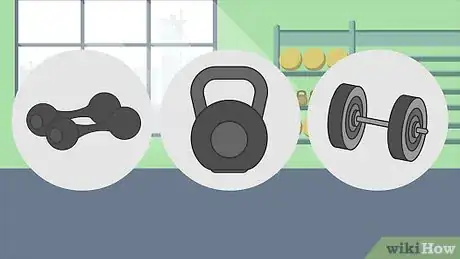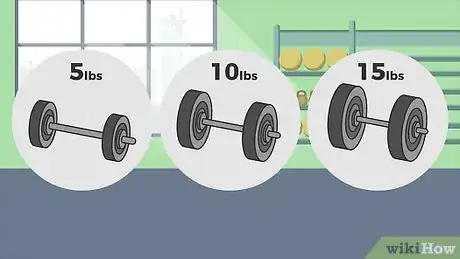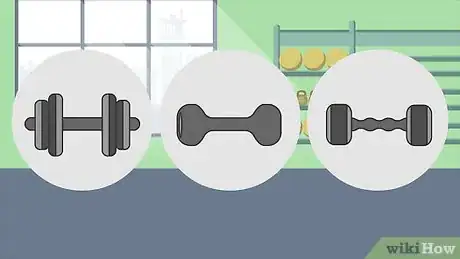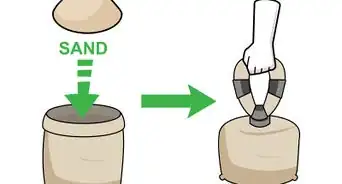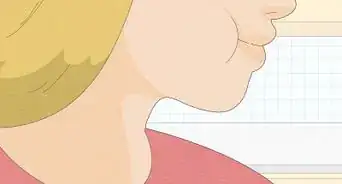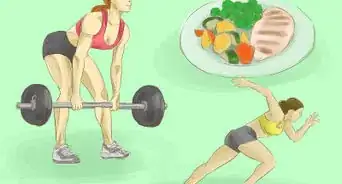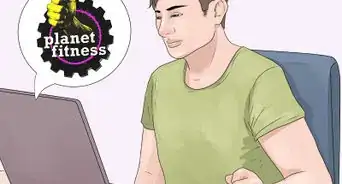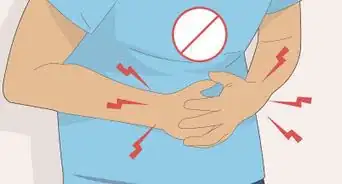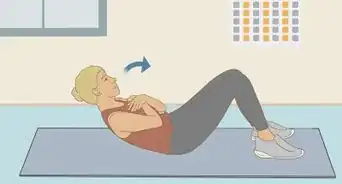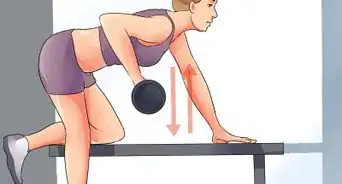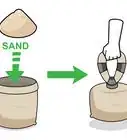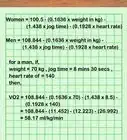This article was co-authored by Monica Morris. Monica Morris is an ACE (American Council on Exercise) Certified Personal Trainer based in the San Francisco Bay Area. With over 15 years of fitness training experience, Monica started her own physical training practice and gained her ACE Certification in 2017. Her workouts emphasize proper warm-ups, cool-downs, and stretching techniques.
There are 10 references cited in this article, which can be found at the bottom of the page.
wikiHow marks an article as reader-approved once it receives enough positive feedback. This article received 15 testimonials and 90% of readers who voted found it helpful, earning it our reader-approved status.
This article has been viewed 1,185,519 times.
Sometimes it's just way more convenient to work out at home instead of in a packed, sweaty gym. If you share this sentiment, purchase some hand weights (which are also called dumbbells) and give these exercises for your whole body a try.
Steps
Selecting Your Hand Weights
-
1Know what hand weights are good for. Keep in mind that hand weights are also called dumbbells or free weights. Exercises that use hand weights are good for building up strength, increasing your endurance, and building muscle mass.
-
2Purchase a set of hand weights if possible. It is good to buy varying dumbbell weights because you can then progressively challenge yourself as you progress with your weight training. The standard combination of weight to buy is two 5 pound (2.2 kg) weights, two 10 pound (4.5 kg) weights, and two 15 pound (6.8 kg) weights. To test whether or not a set is good for you, pick up the smallest weight in the group. Lift and lower this hand weight 10 times. If you are exhausted and don’t think you could do more than 10, that weight set is too heavy.[1]
- Similarly, If you have spent a lot of time working out and think that these weights won’t challenge you, purchase heavier weights. Employees at your local sport goods store should be able to help you determine which set of weights will work best for you.
Advertisement -
3Decide what kind of style you want. Some hand weights have contours that guide you as to where to put your fingers. Others are smooth. They come in a variety of colors and materials, including metal, neoprene or plastic. Determine which kind you want based on your personal preference.
- Keep in mind that a hand weight that has a grip that is too wide will cause more fatigue than normal.
-
4Determine the number of reps you are comfortable with. Reps are the number of times you do a certain exercise. Listed below are different exercises you can do with hand weights. The number of reps, however, is up to you and your comfort level. Generally, a person just beginning to use dumbbells will begin with 10-12 reps on each exercise and then work his/her way up from there.
Working Out Your Chest
-
1Bench press with hand weights. You will need a stepping stool, camping cooler or workout bench for this exercise. You could also lie on the floor, an exercise ball or stack some books for extra spinal support. Lie back on the camping cooler or bench so that your knees touch the edge of the platform and your feet are firmly planted on the ground.
- Hold a dumbbell in each hand. The dumbbells should be lying along your body at chest level. Your palms should be facing towards your feet.
- Raise the dumbbells straight up towards the ceiling. Your elbows should be close to locking but they should not quite lock. Hold the dumbbells in the air for a moment, keeping your arms steady.
- Lower the dumbbells back to your chest and repeat these steps.
-
2Do the Lying Fly exercise. You will again need a bench or camping cooler for this exercise. You can also lie on the floor or on an exercise ball or stacking books. You must lie with your knees touching the edge of the camping cooler or bench and your feet firmly planted on the ground.[2]
- Grab a dumbbell with each hand. Spread your arms so that they run perpendicular to your body, holding the dumbbells at body height.
- Raise the dumbbells until they are side by side above you. Hold them there for a moment and then lower them back to body height.
- Try to keep your elbows bent at the same angle throughout this exercise.
-
3Do the straight-arm pullover. Lie on the top end of your bench. Your feet should be firmly and flatly placed on the ground.
- Hold a one hand weight with both of hands so that your arms extended above your head. You should try to keep your arms as extended as possible.
- Raise the hand weight straight up into the air. The top of one end of the hand weight should be facing the ceiling. Hold the weight in place for a moment.
- Slowly release your arms back down to their position above your head. Repeat.
EXPERT TIPMonica Morris is an ACE (American Council on Exercise) Certified Personal Trainer based in the San Francisco Bay Area. With over 15 years of fitness training experience, Monica started her own physical training practice and gained her ACE Certification in 2017. Her workouts emphasize proper warm-ups, cool-downs, and stretching techniques.Certified Personal Trainer
 Monica Morris
Monica Morris
Certified Personal TrainerMake sure to work your serratus muscle. Get one heavier weight and hold it with both of your hands. Lie in a straight position, then take that weight and lift it over and behind your head with your arms straight, then bring it above your belly button.
Working Out Your Back
-
1Do the wide row exercise. Working out your back will not only make you look good, but it will also keep your back healthy and strong. For this exercise, keep in mind that you should breathe out when lifting the dumbbells up, and breathe in when releasing them back into resting position.
- Get into a semi-squat position with your torso flexed forward while bending at the hips. Keep the back straight throughout. Hold one dumbbell in each hand so that your palms are facing your body. The dumbbells should start just below your knees.
- Lift the dumbbells straight up so that your arms form right angles. You should not alter how your knees and hips are bent.
- Hold the dumbbells up for a moment and then let them slowly drop back down into resting position.
-
2Do the deadlift exercise. The deadlift will work out your back (extensors), glutes, and hamstrings.
- Stand straight with the knees slightly bent.
- Lower the dumbbells until they hang over the top of your feet by bending at the waist. Keep your back straight, and do not move your legs. You should feel a stretch in your hamstrings.
- Raise yourself back up slowly to starting position. Repeat.[3]
Working Out Your Shoulders
-
1Do a palms-in shoulder press. Have toned shoulders can be very attractive and really well-toned shoulders can even be seen through clothing. Impress your crush with some rocking shoulders.[4]
- Stand up, holding dumbbells in both hands. Hold the dumbbells at shoulder level. Your palms should be facing each other.
- Extend your elbows until they come close to locking. The dumbbells should get raised straight into the air--hold them in this position for a moment.
- Slowly lower your arms so that the dumbbells are back at shoulder level.
EXPERT TIPMonica Morris is an ACE (American Council on Exercise) Certified Personal Trainer based in the San Francisco Bay Area. With over 15 years of fitness training experience, Monica started her own physical training practice and gained her ACE Certification in 2017. Her workouts emphasize proper warm-ups, cool-downs, and stretching techniques.Certified Personal Trainer
 Monica Morris
Monica Morris
Certified Personal TrainerThree-pound dumbbells are perfect for working your shoulders. Try a shoulder routine with lateral raises, sideline lateral raises, medial deltoid raises, and anterior deltoid raises. Those four exercises will work almost your entire deltoid.
-
2Do a seated shoulder press. Sit on the edge of a chair, bed, workout bench, couch or box.
- Lift the dumbbells so that they are at shoulder height with your palms facing forward.
- Push the dumbbells straight in the air. Your elbows should come close to locking but do not lock.
- Hold the dumbbells in the air for a moment and then slowly lower them back to your shoulders.
-
3Do a lateral raise. Lateral raises are a great standing exercise to buff up and tone your shoulders. You can also do them while sitting but instead of holding the dumbbells in front of you, hold them down by your sides.[5]
- Hold a dumbbell in each hand and hold your hands in front of your hips. Your palms should be facing each other.
- Lift your arms out to your sides until they are almost parallel with the ground. Hold them in this position for a moment and then release them back down to your hips.
Working Out Your Biceps
-
1Do an alternating bicep curl. A bicep curl is the standard bicep workout done with hand weights. Doing an alternating curl means you switch back and forth between your arms so that you get an even workout.[6]
- Stand with your feet apart and flat on the ground. Hold a dumbbell in each hand and let each hand hang down at your side with your palms facing forward. As you curl up, your palms should be facing your shoulder.
- Raise your right dumbbell so that it reaches shoulder height by curling your forearm up towards your chest. The underside of your forearm should face up towards the sky.
- While lowering the right dumbbell, begin to lift the left one up in the same manner. Avoid jerking your body backwards to help you lift the dumbbells. If you are doing this, your dumbbells are too heavy.
-
2Do a hammer curl. A hammer grab is another way to work out your biceps. This gets its name from the way you hold the dumbbell like the handle of a hammer.
- Grab a dumbbell in each of your hands so that your palms face in towards your body. Hold your arms down by your sides.
- Curl your arms and lift the dumbbells so that the tops of the dumbbells come toward your shoulders. The inner side of your forearm should be facing to the side.
-
3Do a seated isolated dumbbell curl. Seated arm exercises can be great to do while watching TV. This is called an isolated exercise because it only works one of your muscle groups.
- Sit on the edge of a chair or bench. Hold one dumbbell in your right and let your arm hang down so that your right elbow rests against the inside of your right thigh.
- Raise the dumbbell until it almost reaches shoulder height. It should not actually reach your shoulder or else the bicep will disengage. Hold it there for a pause of 5 to 10 seconds and then slowly lower it back to towards the ground.
- Repeat these steps with the other your other arm.
Working Out Your Triceps
-
1Do a two-arm tricep extension. This workout only uses one dumbbell. You can do this while standing or sitting.
- Grasp one dumbbell with both of your hands and hold it behind your head. Your arms should be bent into right angles with your forearms running along the sides of your head so that the dumbbell is behind your head.
- Extend your elbows and lift your forearms so that they are pointed vertically above your head with the dumbbell. Hold that position for a moment and then lower them back to the right angle position behind your head.
-
2Do a triceps kickback. Stand with your back straight, and hinge forward from the hip. Start with arms hanging down, with your elbows to your ribs. This is the start position. Lift from the forearm only, so that the arm straightens parallel with the torso. The palm should turn up as it approaches the hip. As the elbow bends, lower the forearm. Repeat for the desired number of sets and repetitions.
-
3Do a lying-down extension. Lie down on your back either on the ground or on your bed. If you have a workout bench at home, lie down on that.
- Hold a dumbbell in each hand so that your palms are facing up. The outside of your forearms and elbows should be facing up towards the ceiling so that your arms create two upside-down ‘V’s. This is the resting position.
- Raise the dumbbells up to the ceiling by extending your elbows. Hold the dumbbells in the air for a short pause and then lower them back down to the resting position.
Working Out Your Lower Body
-
1Squat with dumbbells. You can easily use dumbbells to add resistance to squats. This exercise will help you build strength in your lower body.
- Hold a dumbbell in each hand while in a standing position.
- Squat straight down by bending your knees. Do this so that the dumbbells are just above the floor. Hold that position for a moment.
- Slowly stand back up, keeping your arms steady, your back straight, and your abs clenched.[7]
-
2Do dumbbell lunges. This exercise will work out your quadriceps in the front of your thighs. These are like normal lunges, only you are holding dumbbells.
- Hold a dumbbell by your side in each hand.
- Take a wide step forward with your right leg and lower your body. Keep your left leg still and your back straight.
- Push your heel down as you raise yourself back to starting position.
- Do the desired amount of repetitions before switching to your left leg. Make sure you do the same number of repetitions for both your right and left leg.[8]
-
3Add weights to calf raises. As the name implies, calf raises will work out your calves. For this, you will need a wooden plank, platform, or a thick book about two or three inches off the ground.
- Grasp a dumbbell in each hand, and hold them by your side.
- Stand with the ball of your feet on a wooden plank or platform. Your heels should begin by resting against the ground.
- Raise your heels while exhaling, and lower yourself on the inhale.[9]
-
4Combine upper and lower body exercises. If you want to increase the intensity of your exercise without increasing the length of your work-out, you can combine upper and lower body workouts. You might try:
- An overhead press as you squat
- Walking lunges with bicep curls
- Sumo squats with upright rows
What Are the Best Exercises for Building Upper Body Strength?
Sample Exercises
Expert Q&A
Did you know you can get expert answers for this article?
Unlock expert answers by supporting wikiHow
-
QuestionHow do I use hand weights to work on my abs?
 Michele DolanMichele Dolan is a BCRPA certified Personal Trainer in British Columbia. She has been a personal trainer and fitness instructor since 2002.
Michele DolanMichele Dolan is a BCRPA certified Personal Trainer in British Columbia. She has been a personal trainer and fitness instructor since 2002.
Certified Fitness Trainer
-
QuestionWhat exercise gets rid of arm flab?
 Michele DolanMichele Dolan is a BCRPA certified Personal Trainer in British Columbia. She has been a personal trainer and fitness instructor since 2002.
Michele DolanMichele Dolan is a BCRPA certified Personal Trainer in British Columbia. She has been a personal trainer and fitness instructor since 2002.
Certified Fitness Trainer
-
QuestionWhat exercises can I do with free weights?
 Michele DolanMichele Dolan is a BCRPA certified Personal Trainer in British Columbia. She has been a personal trainer and fitness instructor since 2002.
Michele DolanMichele Dolan is a BCRPA certified Personal Trainer in British Columbia. She has been a personal trainer and fitness instructor since 2002.
Certified Fitness Trainer
Warnings
- Be cautious about lifting weights that are too heavy. You could pull a muscle or throw out your back if you attempt to lift weights that are too heavy.⧼thumbs_response⧽
- When doing lateral raises, be careful not to do the 'pouring the pitcher' method some people teach. This can cause irreparable damage to the muscles in your shoulder. Instead, do the opposite motion. Stand with your feet shoulder width apart, lean forward slightly to align the muscles in your shoulder, raise the dumbbells and rotate your arm so that your thumb ends up facing upwards and your forearm facing forward. This keeps the muscle underneath the shoulder bone from rubbing against bone, while still exercising your shoulder muscles⧼thumbs_response⧽
References
- ↑ http://www.dummies.com/how-to/content/how-to-buy-dumbbells.html
- ↑ http://www.bodytrainer.tv/en/exercise/dumbbell_lying_fly
- ↑ https://www.bodybuilding.com/exercises/main/popup/name/stiff-legged-dumbbell-deadlift
- ↑ http://www.askmen.com/sports/bodybuilding_1000/1005_shoulder-workout.html
- ↑ http://www.exrx.net/WeightExercises/DeltoidLateral/DBLateralRaise.html
- ↑ http://woman.thenest.com/arm-exercises-weights-sitting-desk-10720.html
- ↑ https://www.bodybuilding.com/exercises/main/popup/name/dumbbell-squat
- ↑ https://www.bodybuilding.com/exercises/main/popup/name/dumbbell-lunges
- ↑ https://www.bodybuilding.com/exercises/main/popup/name/standing-dumbbell-calf-raise
- Videos provided by GymRa
About This Article
To workout at home using hand weights, select the appropriate weights for your skill level, and determine the number of reps that you’re comfortable doing with those weights. If they’re heavier, you might do fewer sets, and if they’re lighter, you might do more reps. Start small by doing simple movements, like bench presses and deadlifts. To work out your shoulders, do lateral raises by extending your arms out to the sides. For an arm workout, do bicep curls and tricep kickbacks, and add extra weight to squats and lunges by holding hand weights. to learn more from our Personal Trainer co-author, like exercises for your lower body and back, keep reading!
